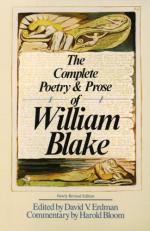
|
| Name: _________________________ | Period: ___________________ |
This test consists of 15 multiple choice questions and 5 short answer questions.
Multiple Choice Questions
1. Those poems dedicated to the same star, in evening and then in morning, are only how many stanzas long?
(a) Three.
(b) One.
(c) Four.
(d) Two.
2. This is amended, thematically, shortly thereafter with, "Thus Urizen spoke collected himself in awful pride / space / Art though visionary of Jesus the soft delusion of Eternity / Lo I am __________________________________." (p. 307).
(a) God the Father and not the destroyer.
(b) God the Almighty and the Father of our Savior, Lord Jesus Christ.
(c) God the terrible destroyer and not the Savior.
(d) Father, Son, and Holy Spirit.
3. The author then moves on to extol the virtues of what kind of love?
(a) Married love.
(b) Parental love.
(c) New love.
(d) Old love.
4. What do the scholars point out about some of these writings?
(a) They are some of his older works.
(b) They are some of his last works.
(c) They have been a little difficult to acquire.
(d) They are not as good as other works by Blake.
5. "She drave the Females away from Los / and ____________________________." (p. 305).
(a) Los drave all the Females from her away.
(b) She drave all the Females away from herself.
(c) Los drave all the Males from her away.
(d) She drave all the Males away from Los.
6. Why is the answer to Number 95 happening?
(a) To feed the animals.
(b) To protect the animals.
(c) To torture the humans.
(d) To serve the purposes of the humans.
7. The poem Fair Elenor functions as a segue into the ones entitled ___________.
(a) Song.
(b) Hope.
(c) Love.
(d) Dance.
8. After the Mad Song, there are two simply called what?
(a) Love.
(b) Song.
(c) Faith.
(d) Dance.
9. At this starting point, Blake presents how many arguments?
(a) Four.
(b) Three.
(c) Five.
(d) Two.
10. Unlike the others, ___________________ exhibits entire poetic stanzas designed to accompany visual art.
(a) "Chaining of Orc."
(b) "Killing of Orc."
(c) "Freeing of Orc."
(d) "Birth of Orc."
11. Why have the inscriptions been included?
(a) So that students can better understand Blake's work.
(b) So that passionate fans of William Blake's can learn more about him through his artwork.
(c) So lovers of art will understand the connection between Blake's poems and visual art.
(d) So Blake would feel his work was being adequately taught.
12. So too does the fact that the subject matter is a combination of truth and _______________.
(a) Love.
(b) Faith.
(c) Fairness.
(d) Fantasy.
13. Of what would Blake like more?
(a) Intelligence and education.
(b) Work.
(c) Friendships.
(d) Money and fame.
14. How many of these poems taken on their own or in the small groups are sufficient to constitute an entire epic?
(a) Three.
(b) None.
(c) Two.
(d) One.
15. Here is yet another portion of the book where there is what?
(a) An expression of Blake's beliefs.
(b) A lull in the plot line.
(c) A change in the writings.
(d) A unique writing structure.
Short Answer Questions
1. Many of the other inscriptions are captions intended to join ___________.
2. Describe the images the author creates.
3. These writings start as what?
4. The author plants _____________ truths into the verses of the second page.
5. Does there seem to be the depth of rhyme or reason for the specific sequence of pictures or phrases that turn out to be lines to a coherent poem?
|
This section contains 539 words (approx. 2 pages at 300 words per page) |

|




